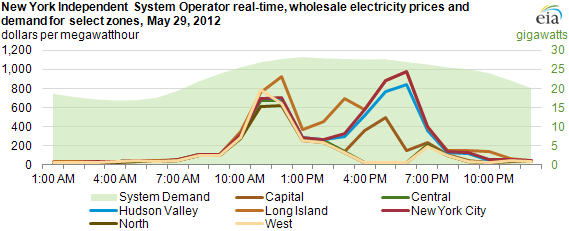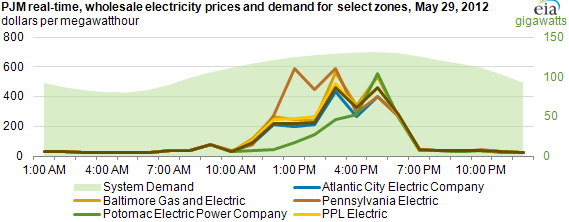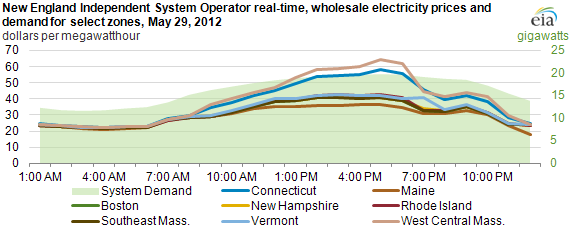
Northeast electricity markets react to hot weather in late May

Note: Prices represent select NYISO zones.
Temperatures in and around New York and Pennsylvania were 10-20 degrees warmer than normal on Tuesday, May 29, lifting electricity demand above seasonal norms. Peak demand in the area served by the New York Independent System Operator (NYISO) was above 28 gigawatts (GW), about 18% below the all-time peak of 34 GW, but high enough to make real-time wholesale prices spike to almost $1,000 per megawatthour (MWh). Adjacent areas in New England and Pennsylvania also saw high real-time wholesale prices.
Many system operators price electricity using Locational Marginal Pricing (LMPs), which in real-time often reacts quickly to imbalances between supply and demand that can result from generator outages, temperature changes, and transmission constraints within the electric system.
Prices across NYISO increased in the earlier portion of the day, reflecting greater-than-expected demand. In the later portion of the day, the more typical pattern of prices spikes into New York City and Long Island reflects demand increases and transmission constraints associated with moving power to those load centers (see a previous Today in Energy article on congestion in the NYISO system).

The highest PJM real-time price occurred at the Pennsylvania Electric zone along the New York-Pennsylvania border, in the early afternoon, similar to the price spike in the New York ISO around the same time. Prices in the eastern regions of PJM (including Jersey City Power and Light and the Atlantic City Electric Company) peaked in the afternoon reflecting a typical pattern of constraints within the PJM system as temperatures peaked in the afternoon.

Although average hourly prices rose only slightly (see chart above) in ISO-New England on May 29, that region did see occasional five-minute prices as high as $500/MWh. Spikes in the five-minute prices drove hourly increases in the real-time market higher in Connecticut and West Central Massachusetts than in the rest of New England in the afternoon.